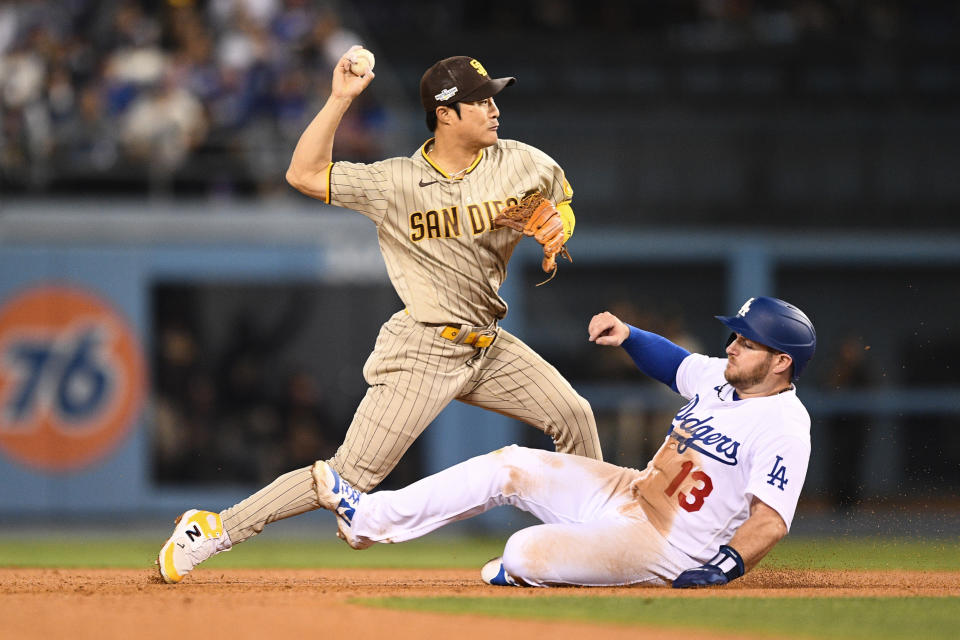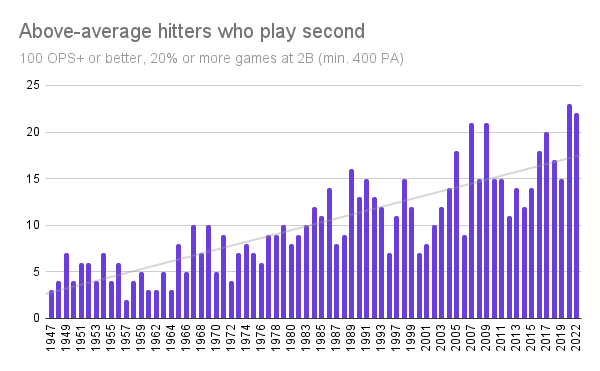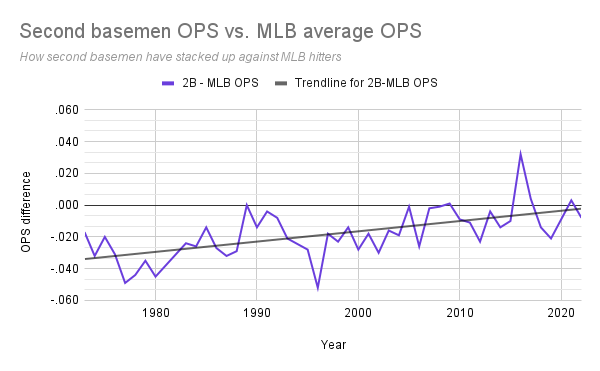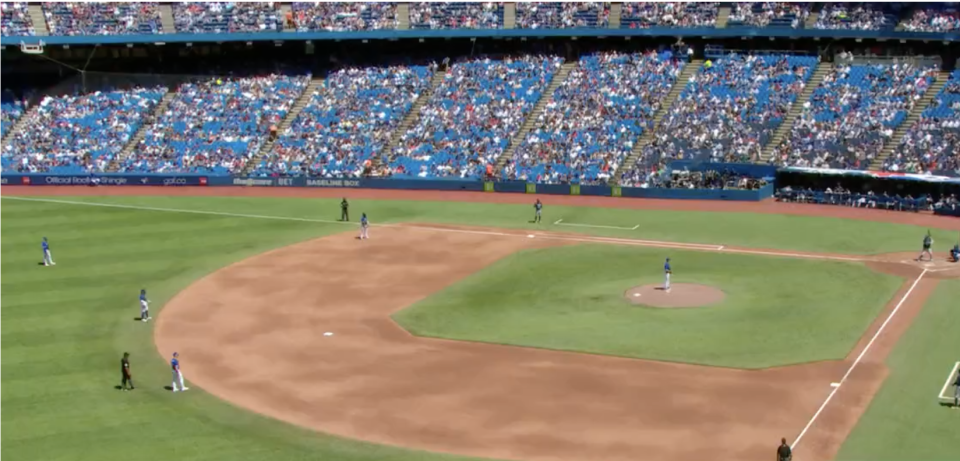If we ever stop calling second base the keystone — or simply want to add a new moniker for the fielding position between first base and shortstop — perhaps we should consider the bellwether. Owing to the wide funnel that leads players to the position, second base has become a beacon we can follow as forces in the game pull teams’ priorities this way and that.
The 2023 MLB season sets up as the start of a new, fascinating era in the history of second basemen, thanks to the dawn of MLB’s infield shift limitations. The area of the field most distorted, crowded and studied by modern defensive tactics will (mostly) be snapped back into its traditional alignment by force of rule. The players who man the position will face new (or old) responsibilities and demands, and entirely different people might find themselves in the role because of those changes.
While most of the attention on the new shift limitations has understandably gone toward understanding how hitters might benefit — how many more hits left-handed sluggers might accumulate under the new rules — there will also be career-altering intrigue in the field. Who is fit to walk the tightrope of second base without the shift’s forgiving net? Who will find the balance between the position’s recent offensive prowess and its traditional defensive bent?
To understand the divergent paths that could emerge, it helps to understand how the idea of a second baseman morphed into its current form.


The position of limitations
Maybe you have a visual archetype of the second baseman: contact-hitting, short, speedy. There’s good reason for that. The two best hitting second basemen by OPS+ since integration are Joe Morgan and Jose Altuve, all-around marvels under 5-foot-9. A bevy of less accomplished major-league fixtures — from the early years of the game through now — also fit that mental mold, in one way or another, without the extreme stature or excellence. It’s not because being short is advantageous, though. That’s just one outcropping of second base’s status as the wild card, the fallback plan, the limbo of the defensive spectrum.
Maybe you also have a scouting archetype of the second baseman: “Not enough arm for shortstop.” There’s good reason for that, too. Athletes with the hands and agility fit for demanding middle-infield duties have for eons shuffled over to second base if they can’t quite make that longer throw to first. Or if their bat doesn’t quite cut it at third base. Or if they are simply usurped by a superior player.
Maybe you have a blurred archetype for what the second baseman used to be. The past 15 years have seen less easily labeled stars float in and out of the spot where Chase Utley and Dustin Pedroia once stood every day, peppering the ranks of Altuve, Robinson Cano and Ian Kinsler with superutility players for whom second base is not exactly home but the closest thing to it.
Ben Zobrist became the poster boy for the keystone-centric versatility wizards, and eventually that model became pervasive. Jeff McNeil, DJ LeMahieu, Ketel Marte and others have since taken up this mantle without the novelty.
Second base is, in one way, the position of limitations. But at its best, it’s the position where players of many shapes and sizes free themselves from their limitations.
Throw softly and carry a big stick
Second base did not evolve from Pesky Slap Hitter Central to the Haven For Diverse Hitters on its own. The proliferation of the infield shift, plus more nuanced advances in defensive positioning, helped expand the range of potential second basemen — in more ways than one.
More precise and more dramatic positioning allowed slower-footed second basemen to hold their own in the field. As a result, more useful hitters who might have otherwise been relegated to first base, left field or even designated hitter found at least part-time roles at an up-the-middle position, in one of the 10 lineup slots that, in theory, requires weighing fielding capability and offensive aptitude.
As teams became more confident in their shifts, in the little cards in every player’s back pocket, they started selecting more and more second basemen for their bats rather than their gloves. It’s not that the prototypical second basemen suddenly got replaced by sluggers, but the toss-up roster spot that might have gone to a middle-infield defensive specialist started going instead to a bat-first option who could manage at second (Wilmer Flores, Marwin Gonzalez, Brandon Drury).
Upon this reality, some players who might have otherwise been shunted onto another path because of their body type or height built careers at second (Daniel Murphy, Matt Carpenter). Others carved out mid-career roles that involved significant and sometimes jarring playing time at the keystone; Mike Moustakas turned Milwaukee’s experiment into a lucrative deal with the Reds. The aesthetic peak of this shift might’ve come in Game 6 of the 2018 NLCS, when the Dodgers and Brewers started the beefy duo of Max Muncy and Travis Shaw at second.
In the meantime, younger players with stellar bats and questionable fielding range emerged into full-time roles either as starting second basemen or utility types with frequent stops there, Brandon Lowe and Luis Arraez among them. Arraez, whom the Minnesota Twins traded to the Miami Marlins on Friday, could well be changing teams because his limited fielding abilities no longer fit as well on the Twins with Carlos Correa, Jorge Polanco and prospect Royce Lewis all locked into or jockeying for playing time.
The result, combined with MLB’s growing preference for defensive flexibility, is an upward trend of better-than-average hitters who play at least some second base.


As a whole, second basemen (and shortstops and catchers and center fielders) historically don’t hit as well as the rest of the lineup because their hitting ability is a smaller chunk of the rationale behind their roster spots. This is the basis for the positional adjustment in WAR and an intuitive truth you can gather by looking at MLB draft results or recalling where the most talented kids on your Little League team played.
Recently, though, the gap between second basemen and the average MLB hitter has been shrinking.


In concert with new hitting philosophies and changes in the baseball that created massive home run surges — and made sluggers of even unspectacular, diminutive second basemen between 2015 and 2021 — the new shape of personnel at the position pulled second base close to and occasionally over the bar of the average MLB hitter, an astounding source of offense and value for teams that struck the right balance.
Will shift limitations reverse the trend?
That balance is about to get a lot trickier. MLB’s infield shift limitations taking effect in 2023 outlaw or severely compromise the main ways teams alleviated defensive pressure on second basemen. There’s a lot of nuance in positioning beyond this, but broadly speaking, it’s easier to field at second if you a) stand farther back, on the outfield grass and b) shade heavily to one side while relying on another fielder, typically the shortstop, to cover the rest.


With infielders required to start each pitch on the dirt and the extreme shift that brought the shortstop across second now banned, second basemen will undeniably have more ground to cover.
Teams employing second basemen whom they’ve papered over defensively will now face the challenge of either shuffling their roster to move those players off second base or locating the best way to cover for them within the new rules. Take the Rays and Lowe. They have a stockpile of middle infielders, most of whom are vastly better defenders than Lowe, but they could really use the thump in his bat and that of a DH in the lineup after finishing 25th in MLB in slugging last year. The Dodgers, on the other hand, could try to use their roster to keep Muncy away from second even more.
At first blush, it would seem that the offense emanating from second basemen, long on the rise, is about to take a tumble. But the ultimate fate of the trendlines isn’t destiny. It’s a product of choices.
The same thought processes that turned Altuve and 5-foot-8 Ozzie Albies into 30-homer mashers pushed a lot of the action off the ground and into the air. The leaguewide ground-ball rate, which stood at 45.1% a decade ago, has come in under 43% in each of the past four seasons. That might not sound like a lot, but it amounts to roughly 2,734 grounders being lifted into the air — or about 91 balls per team per season that are more likely to fall to the outfielders.
Given the relative reliability of projecting offensive performance and the possibility that they can finagle new methods of cracking the defensive code, there’s a chance teams roll with these hitters. There’s also a chance they try to adapt and realize they have to go back to more agile fielders, and thus, the position experiences a delayed-reaction offensive downturn.
Whatever happens, the state of second basemen is going to tell us something about the direction the game is headed. That, though, is one thing that won’t be new.
Follow Yahoo Sports’ Zach Crizer on Twitter @zcrizer.
